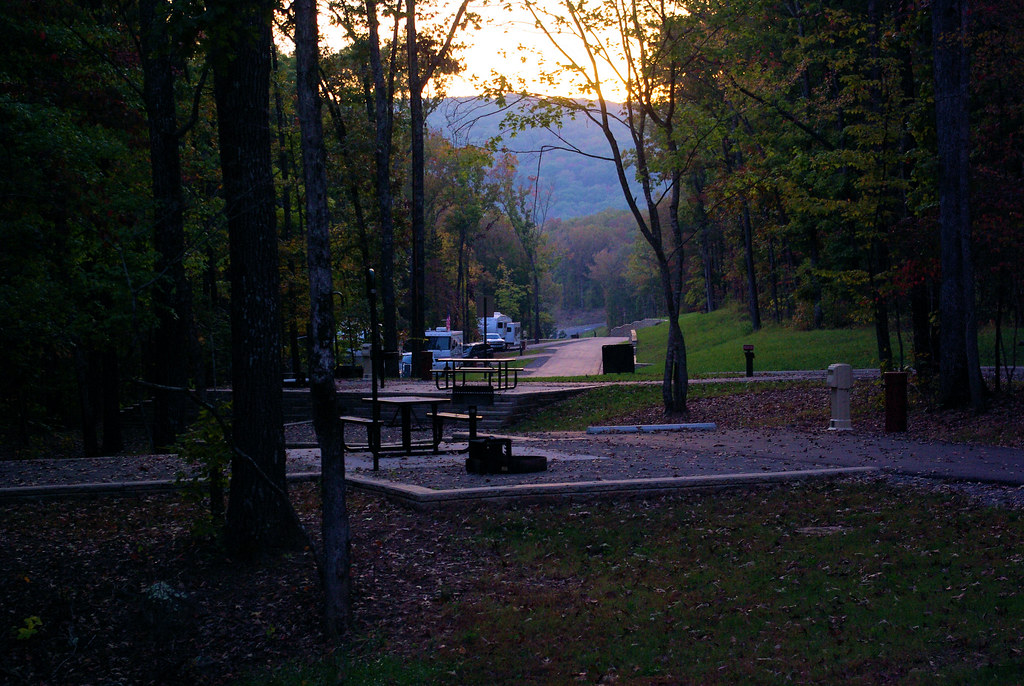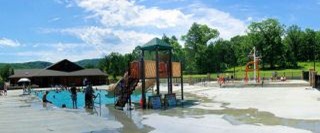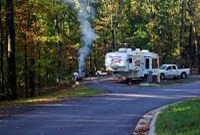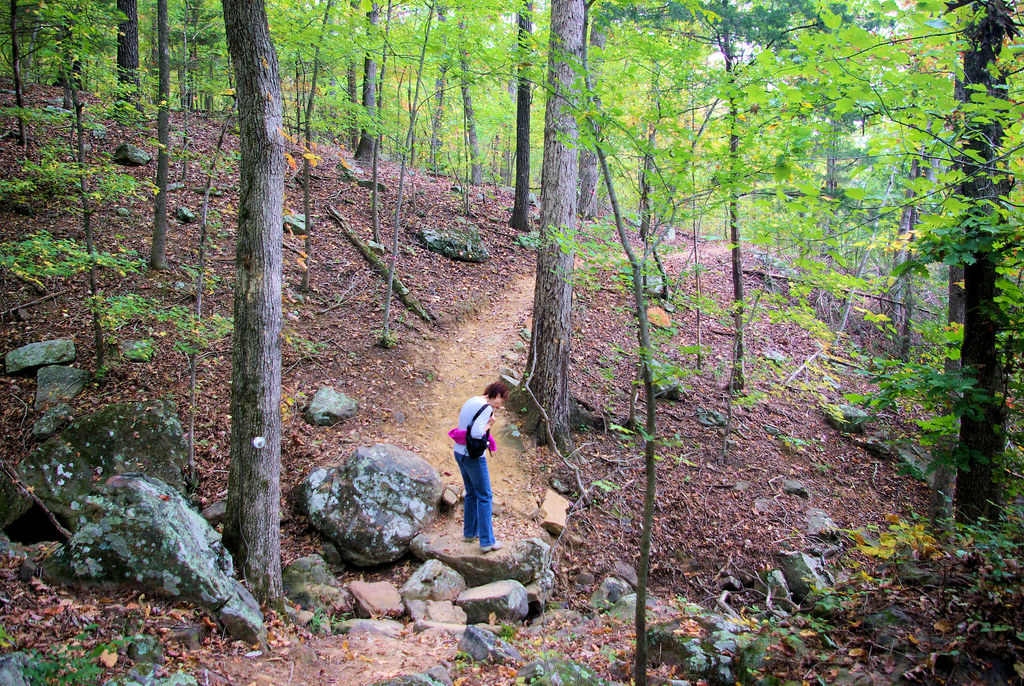The State Park that Moved.
Located in a wooded valley in the Boston Mountains of the Arkansas Ozarks, the 260 acre Lake Fort Smith State Park reopened May 21, 2008 four miles north of its original location, which was closed in early January, 2002, as a park reborn. With totally new facilities, the park has 30 camp sites, 10 cabins, a group lodging facility, picnic sites, a pavilion, marina with rental boats, a double lane boat ramp, a swimming pool, playground, and an 8,000 square foot visitor center with exhibit gallery, gift shop, a meeting/class room, a patio with an outdoor wood burning fireplace, and a great view of the lake and mountains. Activities for visitors include camping, fishing, kayaking, canoeing, backpacking, boating, hiking and mountain biking. The park borders lands of the Ozark National Forest.

Getting There
The park is located just off Scenic Highway 71, eight miles north of Mountainburg, Arkansas. Those traveling I-540 can get to Mountainburg from Exit 29. The closest exit to the park is actually the Chester exit. If you use this exit, follow the signs to Scenic Highway 71 and then turn north (left) on 71. The park entrance is just a short distance down the road on the right. (Note: Some online directions to the park may take you to the original site, not the new location.)
 Swimming
Swimming
Swimming and skiing are not permitted in Lake Fort Smith. Swimming is available at the park’s 2,660 square foot swimming pool, which also has a wading pool and splash pad. The 2250 square foot bathhouse includes changing areas, lockers and a snack bar.
Marina
Visitors can rent canoes, kayaks, pedal boats, fishing boats, and party barges at the park’s marina. Bait, tackle, vending, and other supplies are available. A double lane boat ramp is nearby.
Lodging and Camping
Group lodging facilities include a dining hall and two group lodges. Each group lodge, with single beds, plus private rooms for counselors, can accommodate up to 16 people in each wing. Each lodge has a great room between the two dormitory wings and a kitchenette.
Ten cabins, crafted of stone and wood, are designed to be reminiscent of the WPA style of the old Fort Smith State Park. Some of the reclaimed stone from the old park was used in construction of the cabins. Cabins include one-bedroom and two-bedroom designs featuring a private bath-room for each bedroom. Each cabin includes a great room with wood-burning fireplace, high definition satellite TV, kitchen and dining area. At the back of each cabin is a large, elevated covered deck. Two cabins are barrier-free.
The park has 30 camp sites. Twenty have 50 amp electrical service, water and  sewer hookup. Ten have 30 amp electrical service and water. All sites have a woods view. Hot showers in a heated bathhouse provide year-round convenience. Two sites are barrier-free.
sewer hookup. Ten have 30 amp electrical service and water. All sites have a woods view. Hot showers in a heated bathhouse provide year-round convenience. Two sites are barrier-free.
Reservations for lodging and camping in most Arkansas State Parks are now made online. Campsite reservations can also be made by calling the park at: 479-369-2469. Lake Fort Smith State Park cabin and group facilities’ reservations can be made by calling toll-free: 888-695-3526.
Camping discounts are available for for US citizens 62 and over or with 100% permanent and total disability.
Programs
Park interpretive programs are offered throughout the year, including guided hikes, kayaking, lake tours and demonstrations throughout the park and visitor center.
The park specializes in adventure activities. These include workshops to prepare for outdoor activities, schools in backpacking and kayaking. Outdoor skills workshops may include campfire cooking, birding, safety and survival, outdoor ethics, journaling, art, photography, and more.  Groups may request special programs to meet specific interests.
Groups may request special programs to meet specific interests.
Trails
Near the visitor center is the western end of the Ozark Highlands Trail, which stretches about 165 miles across Arkansas to Buffalo National River. A .6 mile trail, Warren Hollow, runs from the cabin and group lodge area to the visitor center and pool area.
Ozark Highlands Trail
The 165-mile Ozark Highlands Trail, one of the most scenic backpacking trails in the country,  begins near the park’s visitor center. The trail follows the western side of the lake and Frog Bayou for 2.7 miles. There the trail crosses the bayou – no bridge – coming back downstream and following the opposite side of the bayou and lake for about 1.5 miles before turning up Jack Creek.
begins near the park’s visitor center. The trail follows the western side of the lake and Frog Bayou for 2.7 miles. There the trail crosses the bayou – no bridge – coming back downstream and following the opposite side of the bayou and lake for about 1.5 miles before turning up Jack Creek.
Park History
The original Lake Fort Smith State Park began a municipal and county park as part of a 1930s project by the federal Work Projects Administration (WPA). The WPA built dams for two reservoirs, Lake Fort Smith and Lake Shepherd Springs, in the valley upstream of Mountainburg, to serve as part of the municipal water supply system for the City of Fort Smith. A 95 acre recreational park, the  Mountainburg Recreational Facility, was developed by Fort Smith and Crawford County along Frog Bayou below the Lake Fort Smith dam. The WPA project contributed a wading pool, a large swimming pool with two diving towers, four stone veneer cottages, a new road, an arched bridge, a boat house, bridle paths, and landscaping. WPA workers cleared brush and built barbeque pits and stone tables as well as rock houses around the mountain springs.
Mountainburg Recreational Facility, was developed by Fort Smith and Crawford County along Frog Bayou below the Lake Fort Smith dam. The WPA project contributed a wading pool, a large swimming pool with two diving towers, four stone veneer cottages, a new road, an arched bridge, a boat house, bridle paths, and landscaping. WPA workers cleared brush and built barbeque pits and stone tables as well as rock houses around the mountain springs.
The State of Arkansas took over administration of the park in 1967. The pool, which used untreated water directly from Lake Fort Smith, had been closed for health reasons since 1964. Arkansas State Parks built a new Olympic sized pool, remodeled the bathhouse and concession stand, added new playground equipment and constructed a small campground. The park reopened in 1973 as Lake Fort Smith State Park.
With a planned construction of a larger Lake Fort Smith dam that would be built over part of the park, Lake Fort Smith State Park closed in January, 2002, to be relocated to a new site along the shores of the lake. The western trailhead of the Ozark Highlands Trail was relocated to Dockery Gap.
The original Fort Smith Lake Park Dam was retained in place to ensure a continuous water supply for Fort Smith during construction. Built over the site of the swimming pool and the visitor center, the new dam used the original dam for part of its base and is 101 feet higher than its predecessor. The construction joined Lake Fort Smith and Lake Shepherd Springs into a single, larger 1400 acre reservoir. Normal pool level for Lake Fort Smith was raised from 825 feet above sea level to 911 feet, with a capacity of approximately 2.75 billion gallons, triple that of the original reservoirs.
About 500 acres between the two original lakes had to be acquired for the new reservoir. Two historic cemeteries were relocated as were the remains of Native Americans unearthed during construction. Nine hundred feet of the Lake Shepherd Springs dam was demolished.
Lake Fort Smith State Park was relocated to the west side of the new reservoir, at the site of the Lake Shepherd Springs dam. The portion of the dam that was retained is now part of the park’s day use area.
The City of Fort Smith, owner of the park, funded replacement of the original facilities. The State of Arkansas, which leases the land for the state park, paid for additional improvements. The new park buildings incorporate the rustic beauty reminiscent of old WPA buildings with native stonework, vaulted ceilings, wood-paneled walls, and massive wooden beams. Some stones from the old park were used.
More information:
- Lake Fort Smith State Park
- Arkansas State Park website
- Wikipedia (the Wikipedia page for the park only “The addition flooded the site of the old park, and new facilities were built around the new lake.” so I edited it to add more detail about the new park – MpG 4/9/2014)
- Encyclopedia of Arkansas
- GORP
- Ozark Highlands Trail – Ozark Highlands Trail Association (OHTA)
Page updated 1/21/2018 to replace missing photos


